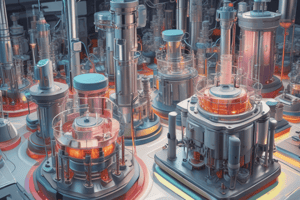Podcast
Questions and Answers
What is the diameter range of the anode disk in the anode assembly?
What is the diameter range of the anode disk in the anode assembly?
- 3-5 cm
- 5-8 cm
- 10-12 cm
- 7-10 cm or more (correct)
Which material is used for the stem in the anode assembly?
Which material is used for the stem in the anode assembly?
- Aluminum
- Copper
- Molybdenum (correct)
- Steel
What is the purpose of the blackened copper rotor in the anode assembly?
What is the purpose of the blackened copper rotor in the anode assembly?
- To cool the anode disk
- To rotate the target stem (correct)
- To insulate electrical components
- To support the anode disk
What component is the anode disk part of in the anode assembly?
What component is the anode disk part of in the anode assembly?
In the anode assembly, how is the rotor described?
In the anode assembly, how is the rotor described?
What factor primarily affects the maximum kV rating in a system?
What factor primarily affects the maximum kV rating in a system?
What happens to the allowable mA rating as the kV increases?
What happens to the allowable mA rating as the kV increases?
Why is the allowable mA low at high kV?
Why is the allowable mA low at high kV?
In which scenario would the maximum mA be lower?
In which scenario would the maximum mA be lower?
What aspect of a system can reduce maximum kV ratings?
What aspect of a system can reduce maximum kV ratings?
What is the position of the diaphragm in relation to the source and detector?
What is the position of the diaphragm in relation to the source and detector?
Where are the sheets of absorbing material located in relation to the source and detector?
Where are the sheets of absorbing material located in relation to the source and detector?
What additional component may be added in front of the detector?
What additional component may be added in front of the detector?
What role does the diaphragm play in the system described?
What role does the diaphragm play in the system described?
Which of the following statements is true regarding the layout of the components?
Which of the following statements is true regarding the layout of the components?
What is another name for unmodified scatter?
What is another name for unmodified scatter?
In unmodified scatter, how does the photon interact with the electron?
In unmodified scatter, how does the photon interact with the electron?
Which of the following best describes the energy behavior of a photon during unmodified scatter?
Which of the following best describes the energy behavior of a photon during unmodified scatter?
What type of scattering occurs when a photon bounces off an electron that is firmly bound to its parent atom?
What type of scattering occurs when a photon bounces off an electron that is firmly bound to its parent atom?
Which of the following is NOT a term associated with unmodified scatter?
Which of the following is NOT a term associated with unmodified scatter?
What happens to the energy carried off by the recoil electron?
What happens to the energy carried off by the recoil electron?
What is the fate of the remainder of the energy after the recoil electron takes its share?
What is the fate of the remainder of the energy after the recoil electron takes its share?
How is the energy carried by the photon characterized after interaction with the recoil electron?
How is the energy carried by the photon characterized after interaction with the recoil electron?
Which of the following statements is true regarding the interaction of photons and recoil electrons?
Which of the following statements is true regarding the interaction of photons and recoil electrons?
What is the primary outcome of a collision between a photon and a material leading to recoil electrons?
What is the primary outcome of a collision between a photon and a material leading to recoil electrons?
What happens to the spectrum of X-rays when they pass through increasing thicknesses of aluminum?
What happens to the spectrum of X-rays when they pass through increasing thicknesses of aluminum?
What is the voltage mentioned in the context of the X-ray generation spectrum?
What is the voltage mentioned in the context of the X-ray generation spectrum?
How does increasing the aluminum thickness affect the low-energy X-rays?
How does increasing the aluminum thickness affect the low-energy X-rays?
What is the purpose of filtration in the context of X-ray generation?
What is the purpose of filtration in the context of X-ray generation?
If the aluminum thickness is increased from 1 mm to 3 mm, what is the anticipated effect on the high-energy X-ray photons?
If the aluminum thickness is increased from 1 mm to 3 mm, what is the anticipated effect on the high-energy X-ray photons?
Flashcards
Anode disk diameter
Anode disk diameter
A circle-shaped component of the anode assembly, ranging from 7-10 cm or more in diameter.
Molybdenum stem material
Molybdenum stem material
A thin metal rod part of the anode assembly made of molybdenum.
Copper rotor function
Copper rotor function
Part of the induction motor and responsible for rotating the target stem.
Anode disk shape
Anode disk shape
Signup and view all the flashcards
Blackened copper rotor
Blackened copper rotor
Signup and view all the flashcards
Maximum kV
Maximum kV
Signup and view all the flashcards
Space charge effect
Space charge effect
Signup and view all the flashcards
Low kV, low mA
Low kV, low mA
Signup and view all the flashcards
High kV, low mA
High kV, low mA
Signup and view all the flashcards
Tube rating
Tube rating
Signup and view all the flashcards
Diaphragm's Role
Diaphragm's Role
Signup and view all the flashcards
Absorbing Material
Absorbing Material
Signup and view all the flashcards
Positioning of Diaphragm and Material
Positioning of Diaphragm and Material
Signup and view all the flashcards
Second Collimator
Second Collimator
Signup and view all the flashcards
Scatter Radiation
Scatter Radiation
Signup and view all the flashcards
Photodisintegration
Photodisintegration
Signup and view all the flashcards
Unmodified scatter
Unmodified scatter
Signup and view all the flashcards
Coherent scattering
Coherent scattering
Signup and view all the flashcards
Classical scattering
Classical scattering
Signup and view all the flashcards
Elastic scattering
Elastic scattering
Signup and view all the flashcards
Recoil electron
Recoil electron
Signup and view all the flashcards
Compton scattering
Compton scattering
Signup and view all the flashcards
Scattered photon
Scattered photon
Signup and view all the flashcards
Energy absorbed by material
Energy absorbed by material
Signup and view all the flashcards
How is energy carried off in Compton scattering?
How is energy carried off in Compton scattering?
Signup and view all the flashcards
X-ray Spectrum
X-ray Spectrum
Signup and view all the flashcards
Filtration Effect
Filtration Effect
Signup and view all the flashcards
Aluminum Filtration
Aluminum Filtration
Signup and view all the flashcards
Increased Filtration
Increased Filtration
Signup and view all the flashcards
Beam Hardening
Beam Hardening
Signup and view all the flashcards
Study Notes
General Information
- This document is a textbook on medical imaging physics.
- It covers the physics of radiation, radiation protection, various imaging modalities, and associated equipment.
- The textbook is written by Penelope Allisy-Roberts and Jerry Williams.
- The book is in its second edition, published in 2008.
Studying That Suits You
Use AI to generate personalized quizzes and flashcards to suit your learning preferences.




